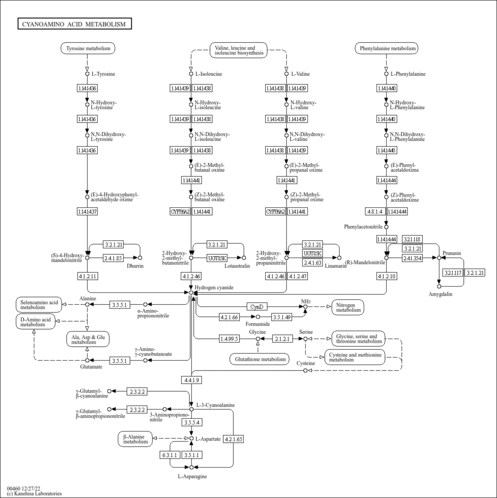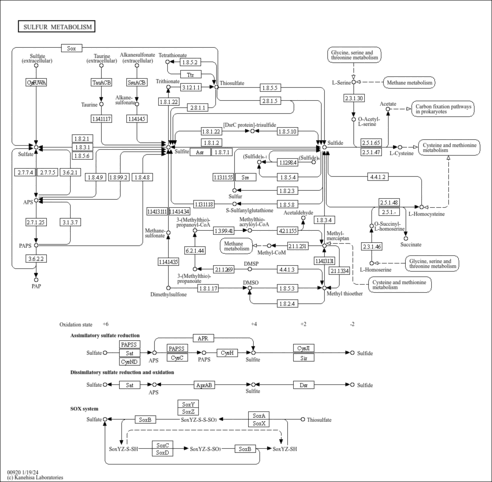Cyanide (YMDB00074)
| Identification | ||||||||||||||||||||||||||||||||||||||||||||||||||||
|---|---|---|---|---|---|---|---|---|---|---|---|---|---|---|---|---|---|---|---|---|---|---|---|---|---|---|---|---|---|---|---|---|---|---|---|---|---|---|---|---|---|---|---|---|---|---|---|---|---|---|---|---|
| YMDB ID | YMDB00074 | |||||||||||||||||||||||||||||||||||||||||||||||||||
| Name | Cyanide | |||||||||||||||||||||||||||||||||||||||||||||||||||
| Species | Saccharomyces cerevisiae | |||||||||||||||||||||||||||||||||||||||||||||||||||
| Strain | Baker's yeast | |||||||||||||||||||||||||||||||||||||||||||||||||||
| Description | Cyanide, also known as chuck norrisium or cyanide ion, belongs to the class of organic compounds known as nitriles. Nitriles are compounds having the structure RC#N; thus C-substituted derivatives of hydrocyanic acid, HC#N. Cyanide is possibly neutral. Cyanide exists in all living species, ranging from bacteria to humans. Cyanide is a potentially toxic compound. | |||||||||||||||||||||||||||||||||||||||||||||||||||
| Structure | ||||||||||||||||||||||||||||||||||||||||||||||||||||
| Synonyms |
| |||||||||||||||||||||||||||||||||||||||||||||||||||
| CAS number | 57-12-5 | |||||||||||||||||||||||||||||||||||||||||||||||||||
| Weight | Average: 26.0174 Monoisotopic: 26.003074005 | |||||||||||||||||||||||||||||||||||||||||||||||||||
| InChI Key | XFXPMWWXUTWYJX-UHFFFAOYSA-N | |||||||||||||||||||||||||||||||||||||||||||||||||||
| InChI | InChI=1S/CN/c1-2/q-1 | |||||||||||||||||||||||||||||||||||||||||||||||||||
| IUPAC Name | methylidyneazanidyl | |||||||||||||||||||||||||||||||||||||||||||||||||||
| Traditional IUPAC Name | methylidyneazanidyl | |||||||||||||||||||||||||||||||||||||||||||||||||||
| Chemical Formula | CN | |||||||||||||||||||||||||||||||||||||||||||||||||||
| SMILES | [C-]#N | |||||||||||||||||||||||||||||||||||||||||||||||||||
| Chemical Taxonomy | ||||||||||||||||||||||||||||||||||||||||||||||||||||
| Description | belongs to the class of organic compounds known as nitriles. Nitriles are compounds having the structure RC#N; thus C-substituted derivatives of hydrocyanic acid, HC#N. | |||||||||||||||||||||||||||||||||||||||||||||||||||
| Kingdom | Organic compounds | |||||||||||||||||||||||||||||||||||||||||||||||||||
| Super Class | Organic nitrogen compounds | |||||||||||||||||||||||||||||||||||||||||||||||||||
| Class | Organonitrogen compounds | |||||||||||||||||||||||||||||||||||||||||||||||||||
| Sub Class | Organic cyanides | |||||||||||||||||||||||||||||||||||||||||||||||||||
| Direct Parent | Nitriles | |||||||||||||||||||||||||||||||||||||||||||||||||||
| Alternative Parents | ||||||||||||||||||||||||||||||||||||||||||||||||||||
| Substituents |
| |||||||||||||||||||||||||||||||||||||||||||||||||||
| Molecular Framework | Aliphatic acyclic compounds | |||||||||||||||||||||||||||||||||||||||||||||||||||
| External Descriptors | Not Available | |||||||||||||||||||||||||||||||||||||||||||||||||||
| Physical Properties | ||||||||||||||||||||||||||||||||||||||||||||||||||||
| State | Solid | |||||||||||||||||||||||||||||||||||||||||||||||||||
| Charge | -1 | |||||||||||||||||||||||||||||||||||||||||||||||||||
| Melting point | Not Available | |||||||||||||||||||||||||||||||||||||||||||||||||||
| Experimental Properties |
| |||||||||||||||||||||||||||||||||||||||||||||||||||
| Predicted Properties |
| |||||||||||||||||||||||||||||||||||||||||||||||||||
| Biological Properties | ||||||||||||||||||||||||||||||||||||||||||||||||||||
| Cellular Locations |
| |||||||||||||||||||||||||||||||||||||||||||||||||||
| Organoleptic Properties | Not Available | |||||||||||||||||||||||||||||||||||||||||||||||||||
| SMPDB Pathways |
| |||||||||||||||||||||||||||||||||||||||||||||||||||
| KEGG Pathways |
| |||||||||||||||||||||||||||||||||||||||||||||||||||
| SMPDB Reactions |
| |||||||||||||||||||||||||||||||||||||||||||||||||||
| KEGG Reactions | Not Available | |||||||||||||||||||||||||||||||||||||||||||||||||||
| Concentrations | ||||||||||||||||||||||||||||||||||||||||||||||||||||
| Intracellular Concentrations | Not Available | |||||||||||||||||||||||||||||||||||||||||||||||||||
| Extracellular Concentrations | Not Available | |||||||||||||||||||||||||||||||||||||||||||||||||||
| Spectra | ||||||||||||||||||||||||||||||||||||||||||||||||||||
| Spectra | Not Available | |||||||||||||||||||||||||||||||||||||||||||||||||||
| References | ||||||||||||||||||||||||||||||||||||||||||||||||||||
| References: |
| |||||||||||||||||||||||||||||||||||||||||||||||||||
| Synthesis Reference: | Furuki, Masakazu; Moriguchi, Yuzo; Akakabe, Tethuro; Kitamura, Hiroyuki. Cyanide production with excess sludge incineration. Hyogo-kenritsu Kogai Kenkyusho Kenkyu Hokoku (1974), 6 31-5. | |||||||||||||||||||||||||||||||||||||||||||||||||||
| External Links: |
| |||||||||||||||||||||||||||||||||||||||||||||||||||
Enzymes
- General function:
- Involved in thiosulfate sulfurtransferase activity
- Specific function:
- Thiosulfate + cyanide = sulfite + thiocyanate
- Gene Name:
- Not Available
- Uniprot ID:
- Q08686
- Molecular weight:
- 34218.60156
Reactions
| Thiosulfate + cyanide → sulfite + thiocyanate. |
- General function:
- Inorganic ion transport and metabolism
- Specific function:
- Thiosulfate + cyanide = sulfite + thiocyanate
- Gene Name:
- FMP31
- Uniprot ID:
- Q08742
- Molecular weight:
- 16697.19922
Reactions
| Thiosulfate + cyanide → sulfite + thiocyanate. |
- General function:
- Inorganic ion transport and metabolism
- Specific function:
- Thiosulfate + cyanide = sulfite + thiocyanate
- Gene Name:
- Not Available
- Uniprot ID:
- Q12305
- Molecular weight:
- 15413.2002
Reactions
| Thiosulfate + cyanide → sulfite + thiocyanate. |


